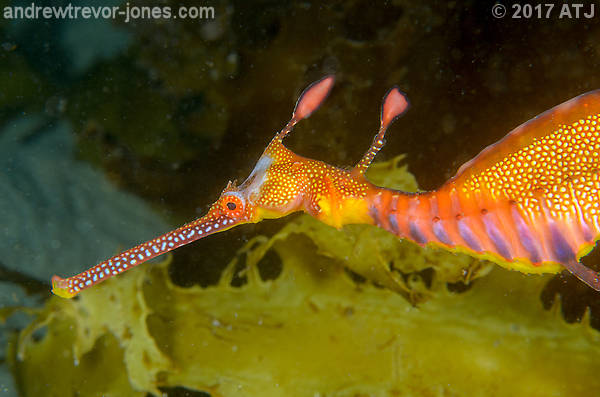
"Clyde" with damage to his head on 23 September 2017.
Wednesday 21 February 2018
I was diving at The Leap, Kurnell on 23 September 2017 when I came across a male weedy seadragon with new eggs. Male weedy seadragons with eggs is a common sight at Kurnell in September but what was different about this seadragon was that he had quite extensive damage to his head. I don't know how the damage occurred and at the time I didn't know if he would survive. I watched him over the following months and this is his story. I have called him "Clyde".

"Clyde" with damage to his head on 23 September 2017.
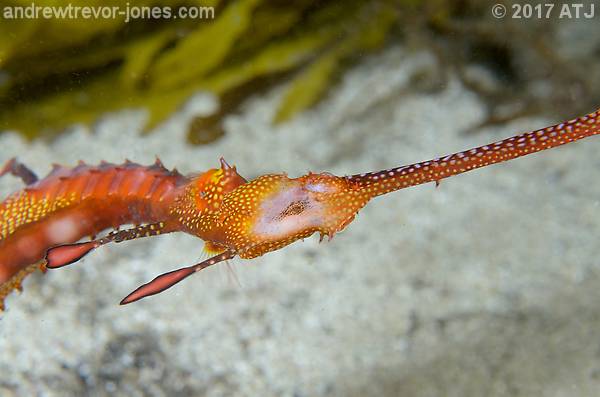
Close-up of the damage on his head.
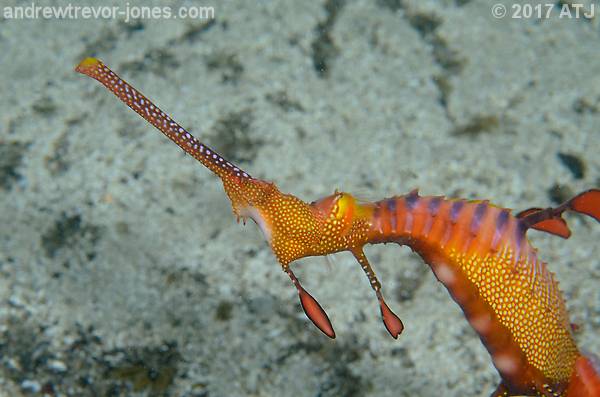
Close-up of the damage on his head.
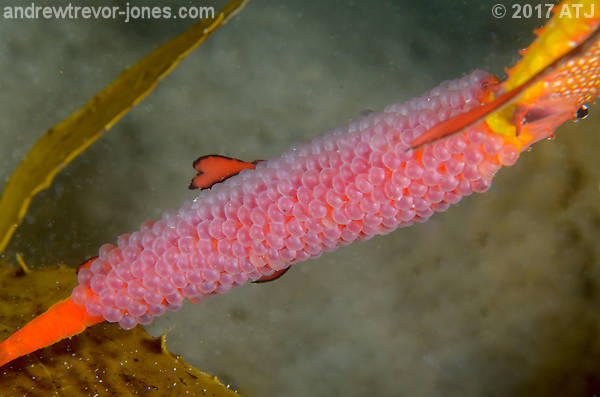
The new eggs on his tail.
Weedy, or common, seadragons, Phyllopteryx taeniolatus, are found along the southern coast of Australia from Port Stephens in New South Wales around to north of Perth in Western Australian and also around Tasmania. Their distribution is not continuous but rather there are numerous isolated populations at various locations. They are the same species throughout their distribution however there is some variation in colour, size and shape between the major population areas.
After seeing "Clyde" on subsequent dives and watching the process of healing of his damaged head and the development of his eggs, I went back through my photographs of weedy seadragons at Kurnell over the last few years to determine if I had seen "Clyde" previously and if so, when I first saw him.
Weedy seadragons used to be very common around Botany Bay with some quite large populations, especially at Kurnell. Subsequent development projects in Botany Bay over the years, mostly with dredging, combined with a few large storms has reduced the populations around the bay. They are still common at Kurnell but there numbers are greatly reduced from as little as 10 years ago.
I have been photographing weedy seadragons at Kurnell for around 10 years and I now take head and flank shots from each side of each weedy seadragon I see. The pattern of spots on the snout as well as the patterning on their flanks is unique to each seadragon and works much like a fingerprint.
There is software available which is based on face-recognition algorithms that can be used to identify weedy seadragons by their flank patterns. I'm old school and I instead inspect the spots on their snouts. I have found that while there are some minor changes to the spots over time such as some spots combining and others splitting, I can reliably identify individuals from their snout patterns.
"Clyde" was somewhat more easily to identify as the shape of the second appendage on his head is quite unique. This makes him easily recognisable while I'm diving. I didn't just use his second appendage as his identifying feature and also used his snout patterning to be sure of each sighting I have had of him.
It turns out that I first saw "Clyde" on 31 July 2016. Based on his photographs I estimate he was between 8 and 12 months old. I suspect he hatched from an egg on his father's tail early in the breeding season of 2015/2016.

"Clyde" on the first day I saw him on 31 July 2016.
Like their seahorse cousins, it is the male weedy seadragon that carries the fertilised eggs until they hatch. Male weedy seadragons carry their eggs on the undersurface of their tail instead of a pouch as in seahorses. The larval weedy seadragons hatch directly from the eggs that are attached to their father's tail. It is suspected that larval weedy seadragons move to shallow water for protection until they grow. I have never seen larval weedy seadragons after they hatch and have only seen young weedy seadragons when they are much larger.
We may see eggs on the tails of male weedy seadragons at Kurnell from as early as July and as late as February each year. This makes the breeding season from July through to February.
I had seen "Clyde" regularly from July 2016 right through until I saw him with his damaged head in September 2017. I didn't always see him when I dived at The Leap. For example, I didn't see him at all in December 2016, or April 2017. I didn't dive The Leap at all in March 2017. When I saw him with his damaged head and eggs on 23 September 2017 it had been nearly a month since I'd last seen him (26 August 2017). I have since seen "Clyde" almost every time I have dived The Leap from 23 September 2017 until now.
On 29 October 2017, 5 weeks after I first saw "Clyde" with damage to his head and new eggs, his eggs were hatching. I managed to get some photographs of three tails emerging from their eggs. I don't know if the larvae were alive but I have to assume that at least some of his eggs hatched successfully.
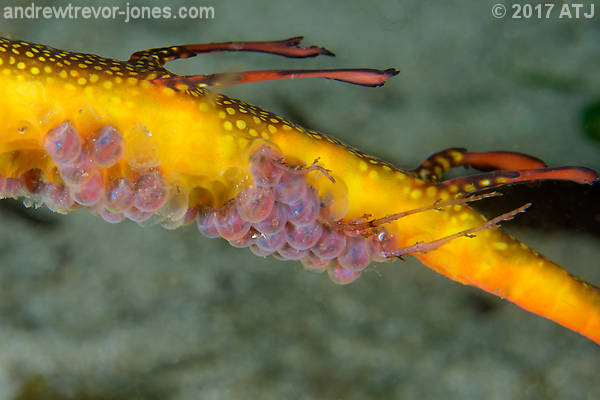
The tails of hatchlings protruding from the eggs on his tail.
Four weeks later, on 23 November 2017, "Clyde" had a new brood of eggs. It had been 10 days since I last saw him and he didn't have any eggs at that time. That made the eggs no more than about a week old.
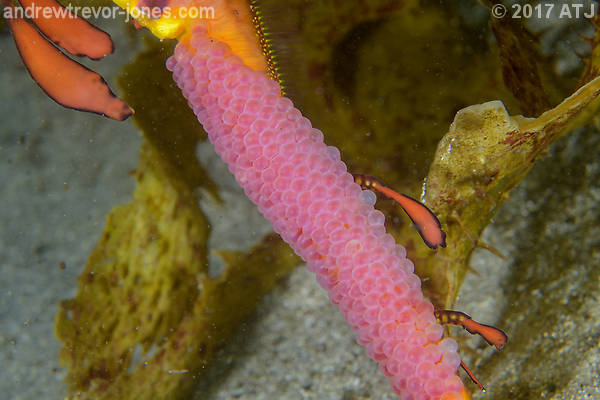
"Clyde" had new eggs on his tail on 23 November 2017.
Less that a week later, on 29 November 2017, the eggs on his tail were starting to disappear. They weren't hatching and something may have been eating them.

Some of the eggs on his tail had disappeared by 29 November 2017.
The next time I saw "Clyde", on 10 December 2017, all but a few of his eggs were gone.
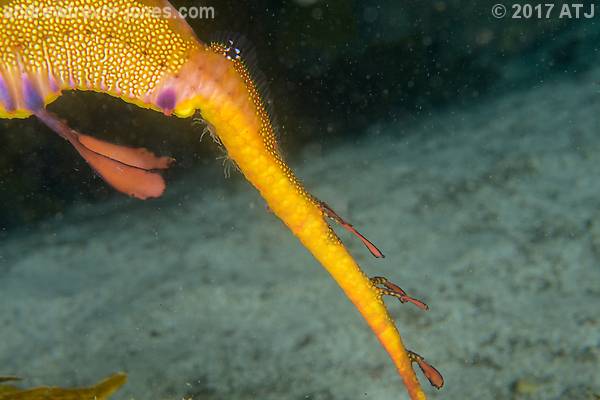
Almost all of the eggs on his tail had disappeared by 10 December 2017.
What was strange was the presence of two growth that looked like anemones on his tail.

Strange growths on his tail.
I saw "Clyde" four more times in December 2017 and three times in early January 2018. I was pleasantly surprised when I saw him on 21 January 2018 that he had yet another new brood of eggs. I'd last seen him on 8 January when he had no eggs so potentially these eggs were up to nearly 2 weeks old. This was also his third brood for the season.
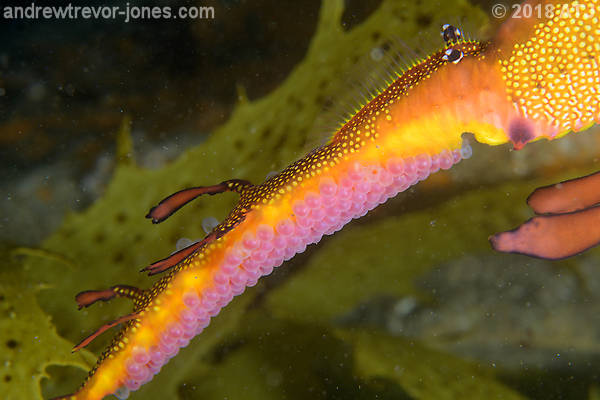
"Clyde" had new eggs on his tail on 21 January 2018.
I saw him a few more times over the next few weeks and was eagerly watching the development of his eggs. On 9 February 2018, I could start to make out the eyes on the eggs.

Eyes are starting to become visible in his eggs on 9 February 2018.
Conditions and working meant that I was not able to dive at The Leap again until 17 February 2018. Even then conditions weren't good and I was not able to find "Clyde" on that dive. Fortunately, I was able to dive again on 18 February 2018 and I found him. Most of his eggs had already hatched but I did see at least one tail poking out from the eggs.
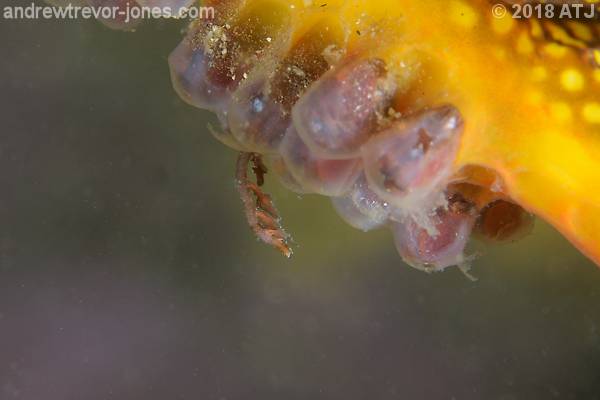
The tail of a hatchling poking out from an egg on his tail on 18 February 2018.
And what of the damage to his head? It has been healing well. A month later on 29 October 2017, as his eggs were hatching, it didn't look there was much progress.
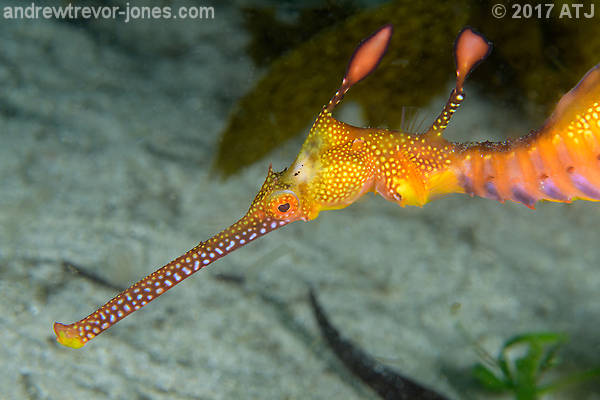
There wasn't much progress to the healing of his head by 29 October 2017.
A month later, on 29 November 2017, and the healing was doing well.

The damage had healed quite a lot by 29 November 2017.
Another month later again and there was only the slightest sign that damage had occurred.
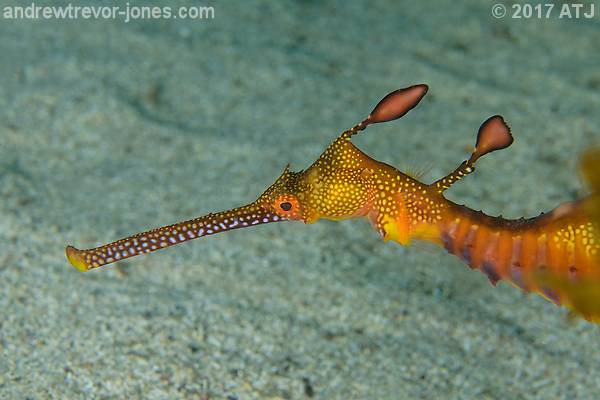
By 20 December 2017, his head was healing well.
Over the next month or so the damage healed completely and by 9 February 2018, it was not possible to see any evidence of the damage.
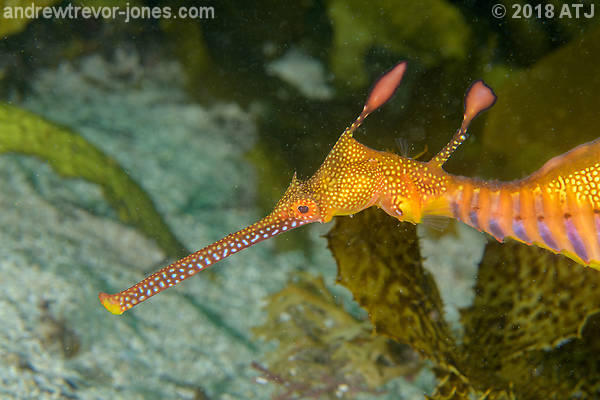
There was no sign of the damage by 9 February 2018.
So... that's the story of "Clyde", or at least part of it. He had 3 broods of which one was unsuccessful but the other two may have resulted in some offspring. He had damage to his head but that didn't seem to affect him and has now healed. hope to continue to see "Clyde" and his fellow weedy seadragons each time I dive at Kurnell. I hope he has more broods in the second half of this year and in the coming years.
Go "Clyde"!
Please leave Feedback if you have any comments or questions about this blog entry.